Mangoes are always one of the most popular fruits out there, but whether you’re a lover of these fruits, or are just looking to try one for the first time, it can be difficult to know how to tell whether or not these fruits are ripe and ready for eating.
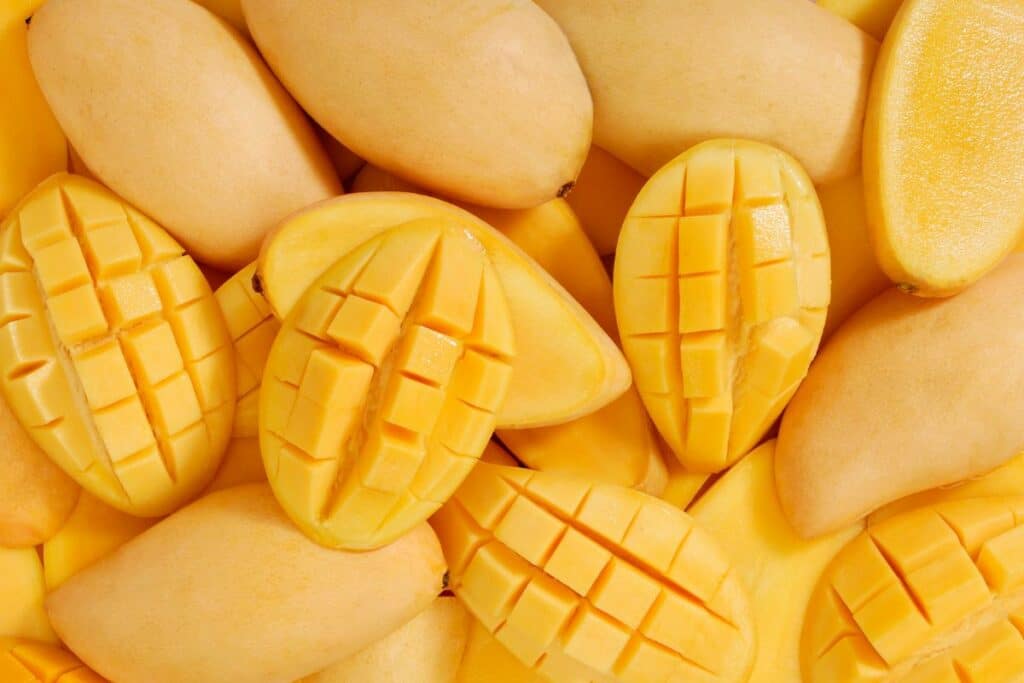
In this guide, we’ll fill you in on all of the information you need to know about these delicious fruits, including how to tell if a mango is ripe, how to cut mangoes properly, how to ripen your mangoes at home, how to keep them properly stored, as well as their nutritional information.
So, for everything mango related, check our guide here!
What Is A Mango?
Much like peaches, plums, and nectarines, mangoes are a stone fruit with a stone seed or pit found in the center of the fruit.
These fruits are a member of the Drupe family, which means that they have an outer skin, fleshy inside, as well as a pit in the middle.
Mangoes are typically grown in more tropical parts of the world, and the flavor of these fruits can vary between tart and sweet, all depending on some factors, including the stage of ripeness, and its variety.
How Are Mangoes Picked?
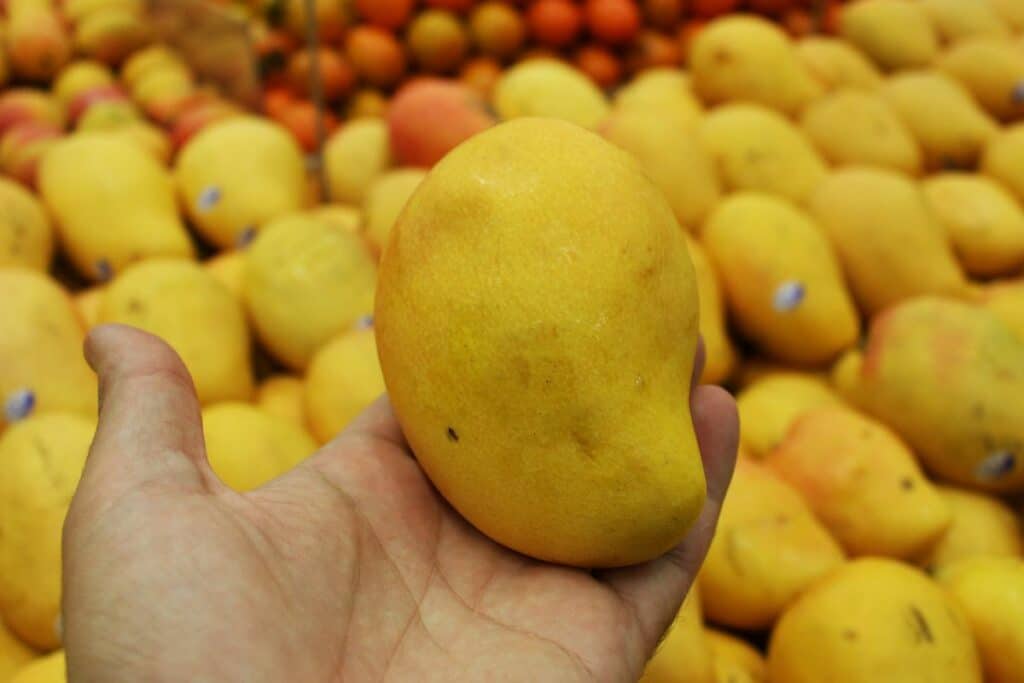
Because mangoes grow on trees, they’re usually either picked by farmers by hand or by dedicated harvesting machines!
Hand-picked mangoes are always the best, as they will have been selected based on their ripeness to ensure that you’re provided with the best taste possible.
How To Choose The Best Mango
Knowing how to select the best mango for you is a difficult task, especially if you’ve never really eaten mango before.
The key thing to remember is that you should always choose the mango based on when you’re planning on eating it.
If you want to enjoy your delicious mango as soon as possible, then the best idea is to try and pick a mango that is ripe, or at least as ripe as possible.
If you’d prefer to buy a mango now and then eat it a few days down the line, then you’ll want to pick a mango that isn’t quite ripe yet.
This will ensure that it has to ripen at home, and will be perfect to eat by the time you want to eat it.
If you’re not sure how to tell whether or not your mango is ripe or not, then don’t panic, as we’ve made sure to provide you with all of the details and information you need to know to ensure that you can pick a mango that is at the right stage of ripening for you!
How To Tell If A Mango Is Ripe
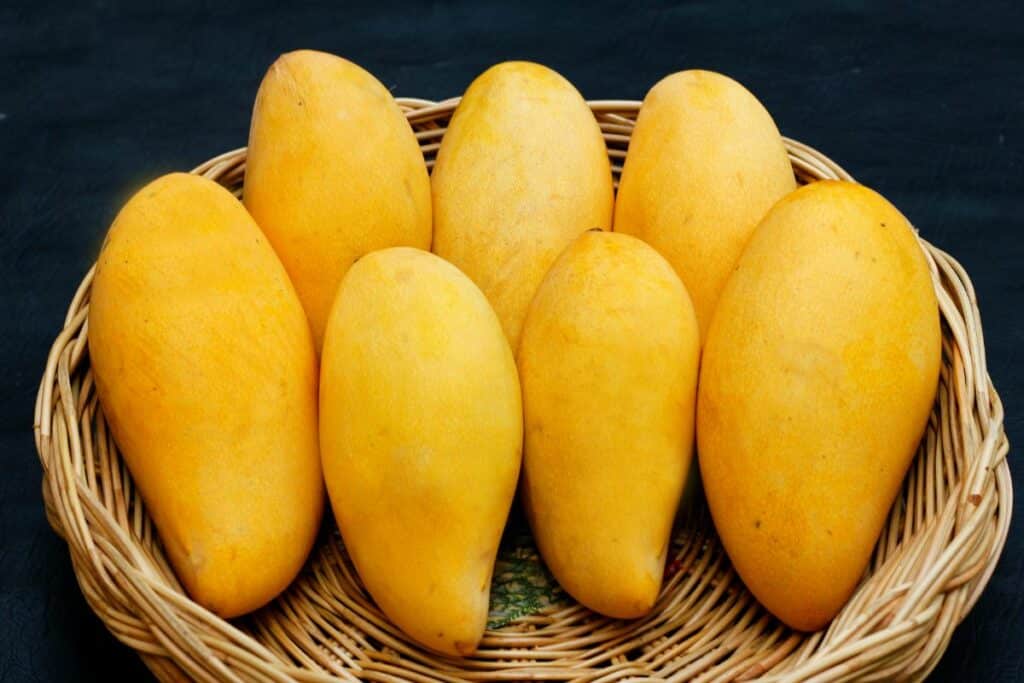
Figuring out whether or not a mango is ripe ultimately depends on how well you can pay attention to some of the intricate details of the fruit.
This includes its color, which can change depending on the ripeness, as well as its firmness too.
It’s also important to know that these factors can also change depending on the variety of mango too.
So, if you’re looking for a comprehensive guide to how to tell when a mango is ripe, then all you need to do is check out the steps below, which will help you to pick the perfect mango every time.
Of course, it varies on the type of mango, but as a general rule, these steps should help you to determine what stage of ripeness the mango you’re picking is at!
- Color: The first, and best way to check whether or not a mango is ripe is through the color. The fruit should have a vibrantly colored skin, which might be red, yellow, or orange, depending on the variety.
- Squeeze: Another great way to test whether or not the mango is ripe is by giving it a slight squeeze. The perfect mango should be somewhat soft when squeezed, but not too squishy or mushy. If the fruit feels too hard or firm, then it’s not fully ripened yet.
- Smell: If the mango is ripe, you should be able to smell its fruity and sweet aroma when holding the stem end up to your nose. If the mango has no smell at all, or has a slightly sour smell, then it means that the fruit is either not ripe, or has over-ripened.
- Wrinkles: A surefire way to check whether or not a mango is ripe without much effort is to check whether or not any wrinkles or lines are running throughout its skin. These lines and wrinkles are a sign that the mango is ripe and ready for eating.
- Stem: One way to check whether a mango is ripe is to lightly press the stem of the fruit. If the stem gives slightly, then you’ll know that the mango is ripe, and is okay to be eaten. If the stem is hard and doesn’t budge, then it’s not ripe yet.
- Juice: Although it’s a slightly less important factor compared to some of the others listed if you notice that the stem of the mango is leaking some of the fruit’s juice somewhat, then this is a sign that it’s ripe. Although, it doesn’t mean that the fruit is unripe if there is no juice leakage.
How To Ripen Mangoes
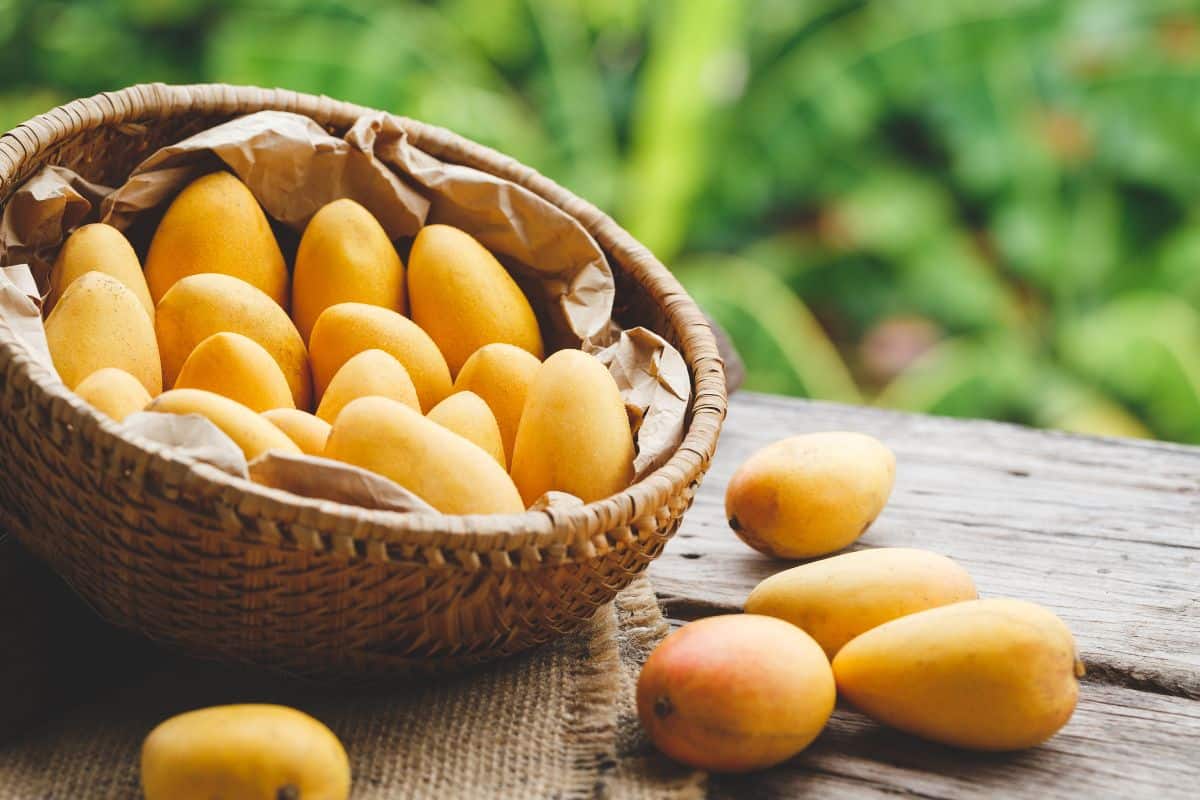
If you’ve bought a mango and have found that it’s not quite ripe or ready to eat, then you’re going to need to know what the best way to ripen your fruit is.
Ripening mangoes at home is relatively easy, and thankfully, there are plenty of different methods that will allow you to do this, so if you need to ripen up your mangoes ready for eating, then try out some of these methods below!
Sit At Room Temperature
If you do not require your mangoes anytime soon, then simply being patient and allowing your mangoes to sit at room temperature in your home will be sure to provide you with deliciously ripe mangoes.
If kept on the countertop, you should be able to expect your mangoes to become ripe within a couple of days, or up to a week, depending on how ripe they were when you bought them in the first place.
Brown Paper Bag Method
Another popular way to help aid your mangoes in their ripening process at home is simply known as the “Brown Paper Bag Method”, and with the help of a plain brown paper bag, you’ll be able to speed up the process!
All you need to do is place your mangoes into a brown paper bag, and then loosely fold the top of the bag over, before placing it on your kitchen counter at room temperature.
By doing this, the ethylene that the mangoes release is kept within the bag, and this will help to make the mangoes ripen quicker.
Using Rice And Popcorn
Instead of the paper bag method, some people prefer to place their unripened mangoes into either popcorn kernels or uncooked rice, which is another way of ensuring that the ethylene released by the mangoes gets trapped.
For this method, you should only need to leave your mangoes in the rice or kernels overnight, as they’ll be ripened by the morning!
Microwave Method
If you’re absolutely craving your mangoes but they’re not yet ripened, then you’ll definitely appreciate this method of ripening them.
It takes just 15 seconds per fruit too, which means you’ll be able to enjoy your fruit soon.
All you need to do is use a knife to make 4 or 5 slits in the skin of the fruit, and then place it in the microwave for 15 seconds.
While this is a sure way to ripen your mangoes as quickly as possible, it is worth noting that this does have something of an impact on the quality of your mangoes, so if you’re looking to enjoy the sensation of eating a fresh and flavorful mango, then this method might not quite be right for you.
Now that you know exactly what you need to do to help your mangoes become ripe and delicious, it’s also worth learning more about how to properly store them, so that you can be sure to have delicious mangoes ready to eat, any time of the day!
How To Store Mangoes
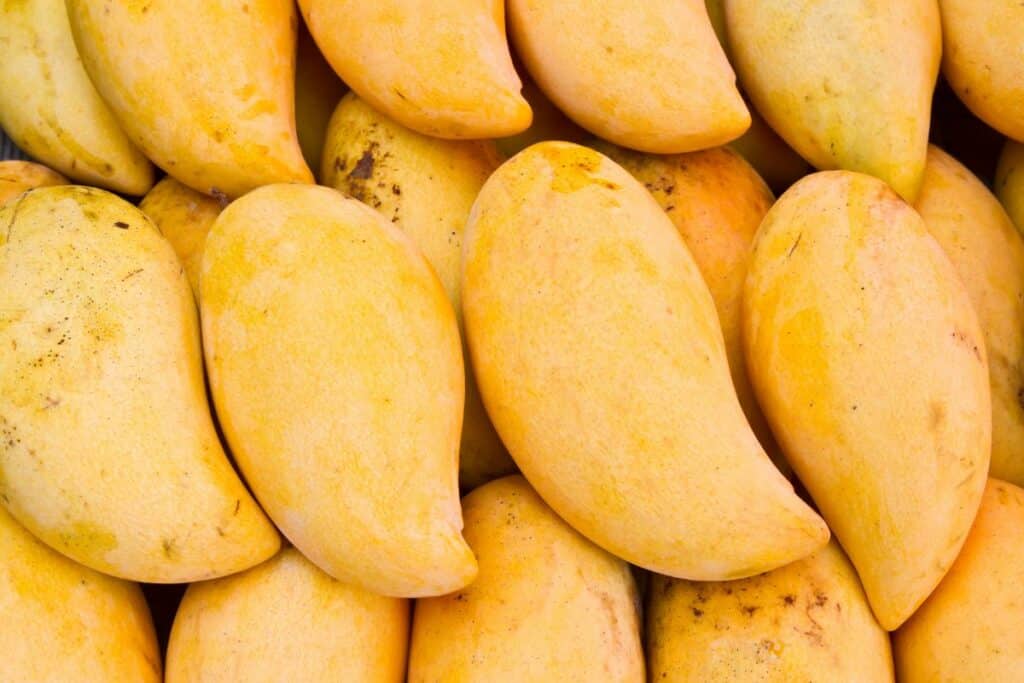
Storing your mangoes at home isn’t a particularly difficult task, and there are three different ways of doing so, all of which will be sure to help your mangoes last until you’re ready to enjoy them.
These methods include refrigerating, freezing, and of course, room temperature.
So, if you’re looking to find out which of these methods is going to be best for you, then check them out below.
Room Temperature
The most common way of storing mangoes is at room temperature, typically in a fruit basket or bowl on the counter of the kitchen.
This is the best way to store your mangoes if they’re not quite ripe and ready to eat yet, as they’ll ripen within a few days.
This way of storing mangoes is best if you’re looking to eat your mangoes within a week or so of buying them.
Refrigerator
If your mangoes have begun to ripen but you’re still not ready to eat them, then it’s a good idea to place them in the refrigerator, where they’ll be able to last for a couple of days to a week depending on the ripeness.
It’s also a good idea to store mangoes that you’ve cut up in the refrigerator too, as it can go bad quickly without protection from its outer skin.
Place your mango pieces into a clean airtight container and eat them within 3 to 5 days.
Freezer
One of the best things about mango is that it freezes well.
So, if you’ve cut your mango into pieces but don’t plan on eating it anytime soon, then placing them in the freezer is the best way to preserve them.
In the freezer, your mango pieces will be able to last for around 3 months.
Be sure to place the pieces into a sealed freezer bag, and then simply place them in your freezer!
When it comes to eating your mango, you’ll want to remove the freezer bag from the freezer and place it into the refrigerator for 8 hours, or overnight, which will allow the mango pieces to defrost properly, so you’ll be able to enjoy them fresh the next day.
Storing your mangoes properly is important, and if they’re stored improperly, there’s a chance that they will go off much quicker than you expect.
But by using one of these 3 methods, you should be able to enjoy your mangoes whenever you want!
How To Cut And Peel Mangoes
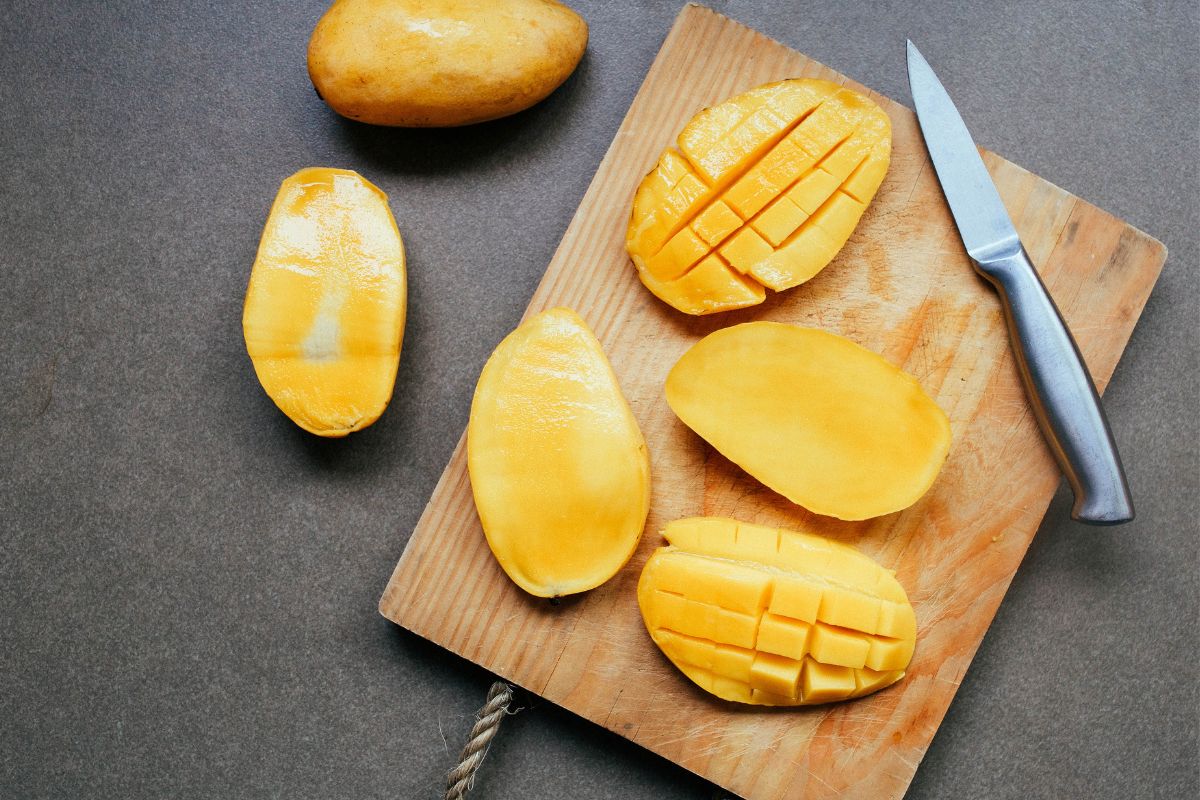
Now that you know how to determine whether or not the mango is ripe, then you’ll be ready to peel and cut your mango ready for eating.
Before you do so though, you should always be sure to wash your mangos in cold water, which will help to remove any germs, dirt, debris, or pesticides that might be residing on the skin of the mango.
If you’ve never cut and peeled a mango before, then you might be slightly confused when we tell you that the best way to prepare a mango is actually to cut it first, and then peel it!
Cutting
To begin, you’ll want to make sure that you pick the right mango to cut. So be sure to follow all of the steps we previously outlined to check that your mango is ripe and ready to be eaten before beginning, as it’s also notoriously difficult to cut an unripe mango.
Stand your mango upright, and then take your knife, and slice down each of its sides, leaving space in the middle where you anticipate the pit is going to be.
You’ll then want to cut the remaining bits on either side of the fruit, which should then leave you with the pit, the two large pieces, as well as the two smaller pieces.
With your mango flesh removed from the pit, you can then begin to cut the flesh into chucks, which is exactly what it will look like when you see pre-cut pieces in the grocery store.
Use the tip of your knife to begin creating equal horizontal lines across the flesh of the cut mango, and then repeat this, but with vertical lines, which should create loads of smaller square shapes in the flesh.
With your mango squares ready, all you need to do now is to remove the flesh!
Removing The Flesh
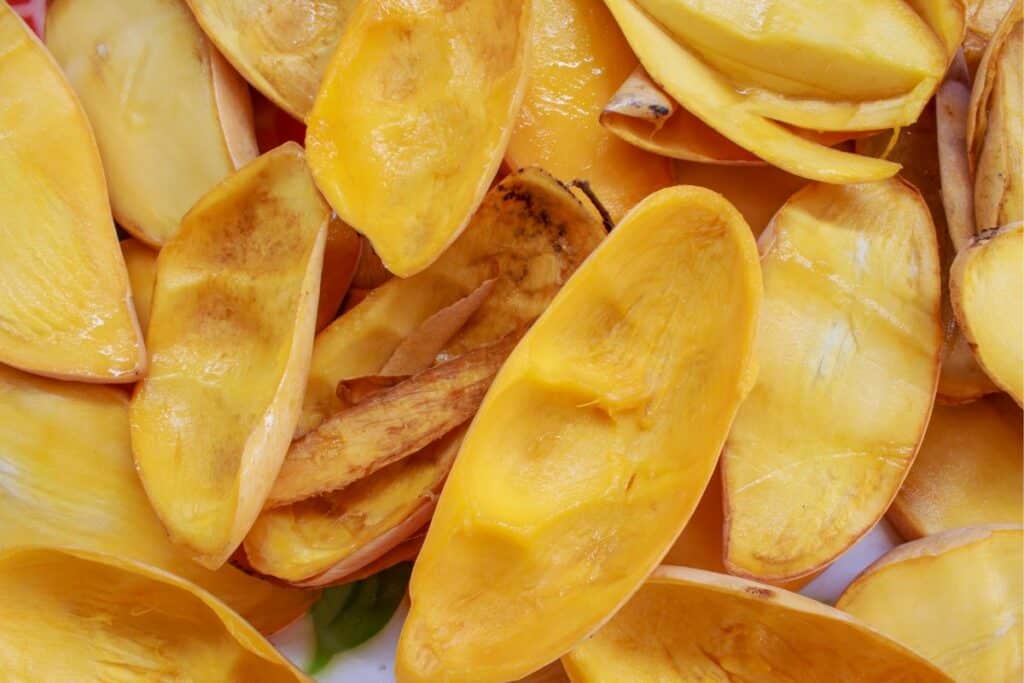
While some people might tend to prefer to use a vegetable peeler in order to get rid of the flesh from their mangoes, the reality is that these methods tend to be much more simple, and are definitely more effective too.
So, whichever one you decide to try, you should have no issues removing the peel from your mangoes and their delicious flesh!
Using A Knife
The most common way of removing the flesh of the mango from its peel is simply by using a knife.
The same knife as you used to cut the flesh in the first place should be just fine.
What you need to do is use the knife to gently cut against where the flesh meets the peel, which should hopefully lead to you removing the peel.
Once the skin is off, you can simply discard it, and focus on eating your yummy mangoes.
Using A Spoon
Another way that some people like to remove the mango flesh from the peel is by using a spoon.
This is a much better method to use if you’re teaching children how to remove the flesh from a mango, or if you don’t have a sharp enough knife in your home.
Grip the spoon firmly, and then use it to begin scraping the flesh away from the peel of the mango. It might be difficult initially, but it should become easier the more you do it.
You can then discard the peel as usual, and enjoy your delicious cubes of mango.
Cup Method
The final method of removing the flesh from the peel of a mango is slightly more unconventional, and definitely less practical, but does work just as well, is by using a glass or a cup!
To do this, you’ll need to get a tight grip on the glass in one hand, and then in the other hand, try to push the mango slide onto the rim of the glass, between where the flesh and the peel meet.
With enough luck, this should then begin to peel away the flesh from the peel, leaving you with the peel to discard, and the amazing mango flesh for you to eat.
Mango Nutritional Information
As a fruit, mango is always a healthy addition to any diet, no matter which way you eat it, but if you’re still wanting to find the nutritional information of the average mango, then hopefully this section should be able to help you out.
Although the nutritional information of a mango can vary depending on the variety, this should provide you with a general idea of what to expect from mangoes!
For 1 cup of freshly sliced and peel mango, you will find:
- Calories: 99
- Fat: 0.6g
- Sugar: 22.5g
- Protein: 1.4g
- Carbohydrates: 24.7g
- Fiber: 2.7g
Mangoes are also bursting with plenty of vitamins and minerals, which is exactly why it’s such a great idea to include them into your diet.
This section will look at the vitamins and minerals found in 1 cup of freshly sliced and peeled mango, and provide you with an estimation of how much of your daily values it meets too!
- Vitamin C: 67% DV
- Vitamin A: 10% DV
- Vitamin K: 6% DV
- Vitamin B6: 12% DV
- Vitamin E: 10% DV
- Potassium: 6% DV
- Magnesium: 4% DV
- Riboflavin: 5% DV
- Folate: 18% DV
- Copper: 20% DV
As you can see, mangoes are an especially healthy fruit, and are great for anyone who is trying to jam pack their diet with plenty of vitamins and minerals.
The Health Benefits Of Mangoes
Aside from being packed with plenty of vitamins and minerals, mangoes have a range of excellent health benefits that they can offer you too, which is even more reason for you to add them to your diet.
One of the most prominent benefits of eating mangoes regularly is that they can help to improve digestion.
This is thanks to the enzymes that are found throughout the flesh of the fruit, which helps to break down the proteins in your stomach.
They can also help with your digestion thanks to the fiber they contain too, which is essential for ensuring that you have healthy and regular bowel movements.
The high amount of vitamin C contained in mangoes also means that they’re great at helping to boost your immune system too, in turn helping to protect you and your body against viruses and illnesses.
The vitamin C found in mangoes can do more than just help your immune system, as it’s also known to help protect the skin against sun damage and inflammation too, helping your skin to remain healthy.
As part of a balanced diet, mangoes make a great addition for any diet, so definitely consider making them a regular occurrence if you haven’t already.
Varieties Of Mangoes To Try
While you might think of mangoes as being just one fruit, much like other fruits, such as apples, there are actually a whole host of mango varieties out there.
The United States commonly sees the distribution of four main varieties, Tommy Atkins, Keitt, Palmer, and Ataulfo.
Out of the four, Tommy Atkins mangoes tend to be the most popular, and are probably the mangoes you imagine when you try picturing them in your head.
This variety is also the most widely distributed variety of mangoes, so unless your local grocery store sells multiple varieties of mangoes, chances are the mangoes available are of this variety.
As mentioned earlier, the different varieties of mangoes can all have different indicators that they’re ripe and ready to eat, so depending on what mangoes you usually eat, you’ll want to familiarize yourself with what a ripe version of your chosen variety looks like!
Tommy Atkins
This variety of mango can vary between being medium or large in terms of its size, and is typically green, but has a red blush when it’s ripe.
These mangoes are usually grown between March and October.
Keitt
These mangoes also vary between medium and large when it comes to their size, and you can tell when they’re ripe thanks to their vivid green coloring.
These mangoes are grown between July and September.
Palmer
Compared to the other mangoes, this variety tends to be much bigger in size, and when they’re ripe, their usual dark green coloring will be complimented by a red blush.
Their growing season begins later than the others though, starting in August, and finishing in October.
Ataulfo: This variety of mango is much smaller than the others, and when ripened they have a golden yellow hue to their skin.
These mangoes have the longest growing season out of these four varieties, starting in July, and finishing in February.
So, the next time you find yourself in the grocery store, why not try to find some of these delicious mangoes to enjoy?
Whether you decide to just go for the basic Tommy Atkins variety, or if you can find them, try out something different, like the Palmer variety?
Just be sure to check that your mangoes are fully ripe before you eat them, and you’ll be guaranteed to love their incredible taste!
Final Thoughts
We hope that this guide to ripe mangoes has been able to help you learn more not only about how you can tell whether or not a mango is ripe, but also more about these incredible fruits.
If you haven’t yet, be sure to try some delicious mango soon. Thanks for reading!
Frequently Asked Questions
Compared to some other fruits, mangoes aren’t necessarily that common, which means that people often have a lot of questions about mangoes.
Thankfully, we’ve created this comprehensive FAQ section to help answer some of the most common questions asked about these delicious fruits.
So, if you’ve got a question about mangoes that has gone unanswered so far, then this should help!
Although it depends on the variety of the mangoes, they’re typically green, with a slight red blush when ripened. Although some varieties, such as the Ataulfo, are yellow in color.
When trying to determine whether or not a mango is ripe or not, refer to our guide earlier in the article, and employ all of the necessary methods to check if the fruit is ripe or not, which should help to ensure your fruit is ready to eat.
If your mangoes are fully ripened and ready to eat, but you’re not needing them yet, or you’ve already cut open your mango, then you should always be sure to store them in the refrigerator, which will help them to stay fresher for longer.
If you’re looking to ripen a mango as quickly as possible, then using a knife to make some slits in the skin, before placing it into a microwave for 15 seconds will help to ripen your mango.
Just be wary that this can significantly reduce the quality of your mango though!
If your mangoes from the store haven’t ripened, then by keeping them stored at room temperature in your home, you can usually expect them to be fully ripened within 3 to 4 days, or sometimes as long as a week.
It can be frustrating waiting for your mangoes to ripen, but we promise it’s worth the wait.
How long a mango can last is dependent on a number of factors. If your mango is not yet ripened, and hasn’t been peeled or cut, then you can usually expect it to last for at least a week, if not more.
For the mangos that have either ripened, or have been peeled and cut, then their time is significantly lowered, and if you plan on keeping them for longer than two days, you should be sure to place them in the refrigerator.
Just like any other fruit or form of fresh produce, mangoes can go bad if left for too long, and spotting a mango that has gone bad is fairly easy to do too.
If your mango is especially soft and squishy to the touch, is oozing large amounts of juice, has begun to go brown in color, and has a slightly bad aroma, then it means that it’s gone bad, and needs to be discarded.
While it’s not toxic or indelible, it really isn’t recommended for you to eat the skin of a mango. So if you plan on enjoying some delicious mango sometime soon, be sure to wash the mango and peel it as per our instructions earlier in the guide.
If you’re looking for the best and freshest mangoes to enjoy, then knowing when the best season for them is important, but it can all depend on their variety.
The most common variety, Tommy Atkins mangoes, can be found in most grocery stores all year round, but for the freshest ones, you’ll want to buy them between March and October!
While it’s not recommended to feed your dogs or pets excessive amounts of fruit due to the high sugar content, your dog should be able to enjoy some small pieces of mango, so long as they’re fed in moderation.
It’s also worth ensuring that the pit is removed from the mango flesh before you give it to your canine companion, as it can be a choking hazard for them.
Thanks to their high amounts of vitamins, minerals, and helpful nutrients, mangoes are an extremely healthy fruit, which is why so many people who are looking to improve their bodily health ensure they include them in their diets!






